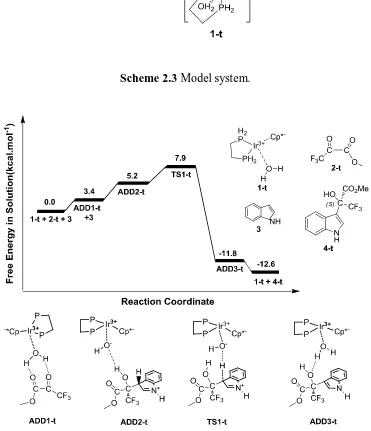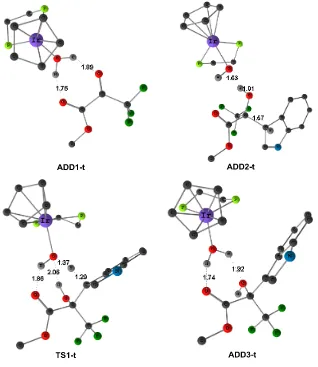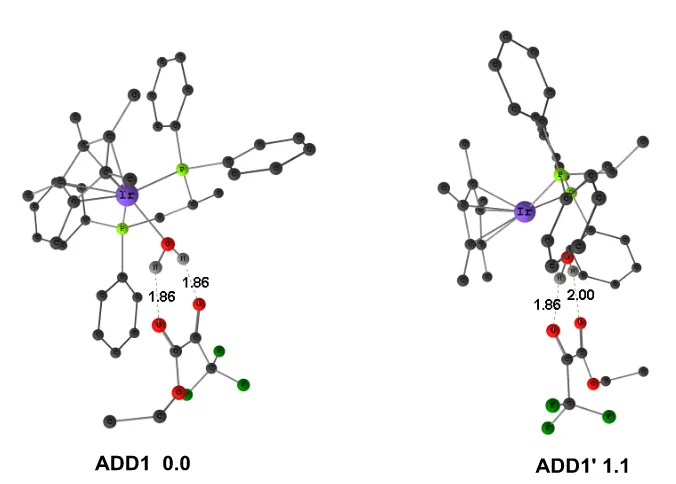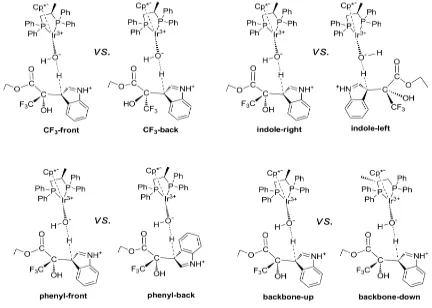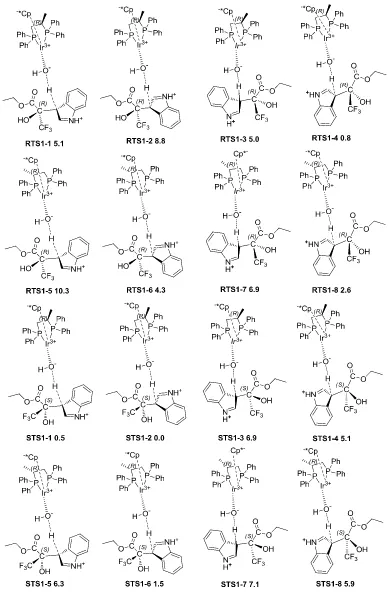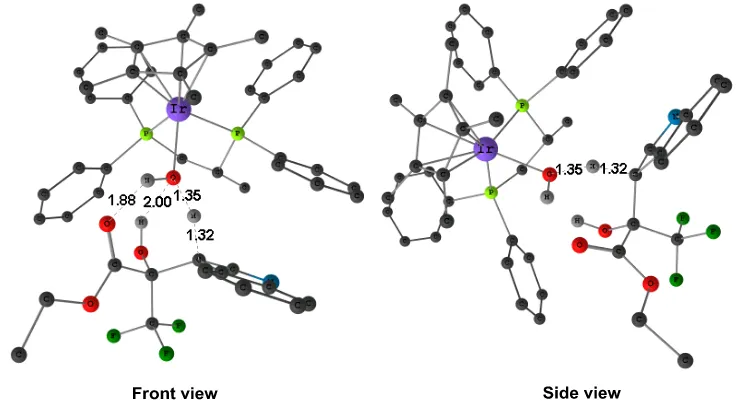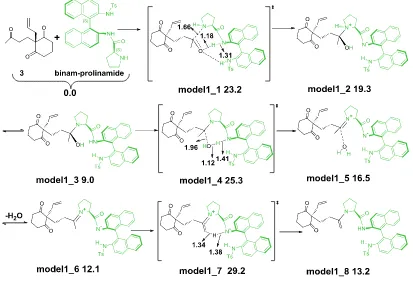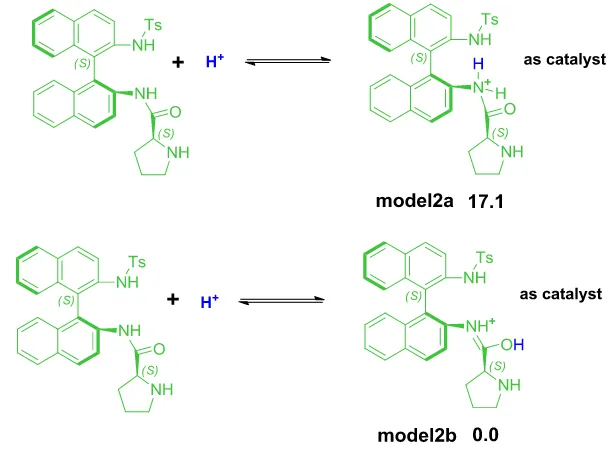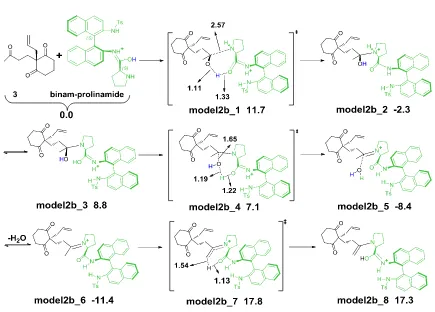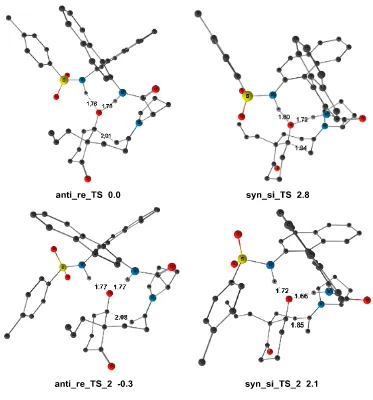COMPUTATIONAL STUDIES ON ORGANOCATALYSIS
Chunhui Liu
Dipòsit Legal: T.192-2014
ADVERTIMENT. L'accés als continguts d'aquesta tesi doctoral i la seva utilització ha de respectar els drets de la persona autora. Pot ser utilitzada per a consulta o estudi personal, així com en activitats o materials d'investigació i docència en els termes establerts a l'art. 32 del Text Refós de la Llei de Propietat Intel·lectual (RDL 1/1996). Per altres utilitzacions es requereix l'autorització prèvia i expressa de la persona autora. En qualsevol cas, en la utilització dels seus continguts caldrà indicar de forma clara el nom i cognoms de la persona autora i el títol de la tesi doctoral. No s'autoritza la seva reproducció o altres formes d'explotació efectuades amb finalitats de lucre ni la seva comunicació pública des d'un lloc aliè al servei TDX. Tampoc s'autoritza la presentació del seu contingut en una finestra o marc aliè a TDX (framing). Aquesta reserva de drets afecta tant als continguts de la tesi com als seus resums i índexs.
ADVERTENCIA. El acceso a los contenidos de esta tesis doctoral y su utilización debe respetar los derechos de la persona autora. Puede ser utilizada para consulta o estudio personal, así como en actividades o materiales de investigación y docencia en los términos establecidos en el art. 32 del Texto Refundido de la Ley de Propiedad Intelectual (RDL 1/1996). Para otros usos se requiere la autorización previa y expresa de la persona autora. En cualquier caso, en la utilización de sus contenidos se deberá indicar de forma clara el nombre y apellidos de la persona autora y el título de la tesis doctoral. No se autoriza su reproducción u otras formas de explotación efectuadas con fines lucrativos ni su comunicación pública desde un sitio ajeno al servicio TDR. Tampoco se autoriza la presentación de su contenido en una ventana o marco ajeno a TDR (framing). Esta reserva de derechos afecta tanto al contenido de la tesis como a sus resúmenes e índices.
Chunhui Liu
Computational Studies on Organocatalysis
DOCTORAL THESIS
Supervised by Prof. Feliu Maseras
TARRAGONA
Institute of Chemical Research of Catalonia (ICIQ) Avgda. Països Catalans 16,
43007 Tarragona (Spain) Tel. (+34) 977 920 200
Prof Feliu Maseras, group leader at the Institute of Chemical Research of Catalonia (ICIQ), and research supervisor for Chunhui Liu.
I STATE that the present study, entitled “Computational Studies on Organocatalysis”
presented by Chunhui Liu for the award of the degree of doctor, has been carried out under my supervision at the Institute of Chemical Research of Catalonia (ICIQ), and that it fulfils all the requirements to be eligible for the Doctorate Award.
Tarragona, September 2013
Doctoral Thesis Supervisor
Acknowledgements
This thesis is an important event in my life - a challenging and exciting one. I am really grateful to a number of people for their assistance and supporting for the fulfillment of this thesis.
First of all I am extremely grateful to Prof. Feliu Maseras, who offered me an opportunity to study at ICIQ (Institute of Chemical Research of Catalonia) by providing me with a scholarship and a hospitable working environment. It has always been a pleasure to discuss with him about the academic issues. His advice helped me a lot in grasping some good
ideas during all my research.
I would like to thank Prof. Fahmi Himo for his hospitality in his group in Stockholm during the summer of 2012. This is a good opportunity to learn new knowledges and new research fields. I believe it is useful for my research in future.
I would like to thank Núria Vendrell for the large help after I came to Spain. If no her, my life would become worse. Also thank Martin Gumbau for helping me with a lot of technical problems.
I would like to thank Maria Besora Bonet and Ataualpa Braga for teaching me a lot of things in the first stages of my research project, especially Maria Besora; she has always been there for me, to help with all the difficulties that arose. I am most grateful for her comments and suggestions during the phase of the development and the writing of this thesis. I also thank Charles Goehry, Chamil Sameera, Carina Backtorp, Steven Donald, Torstein Fjermestad, Abel Locati, Jesús Jover, Laura Mateus, Maxime Mercy, Elena Herrero, Ainara Nova, Víctor Fernández Álvarez, Prof. Carles Bo, Cristina Pubill, Pere Miró, Mickael Gicquel, Simon Pierrefixe, Alex Hamilton, Fernando Gómez, Xavier Sanz López, Dolores Melgar Freire, Nuno Bandeira, Prof. Núria López, Jaime Gómez, Mónica
I am also grateful to my Chinese friends in ICIQ, and in Tarragona with a lot of help when
I'm in trouble and sharing my joy when I am happy.
Lastly, I am indebted to my husband, my parents, my sister and brother, for their love, constant support and patience for all these years. Especially, my husband Peilin Han, I am deeply grateful for his love, moral support, encouragement and patience for finishing my PHD.
The work of this thesis has been possible thanks to financial support from the “Ministerio de Ciencia e Innovación” and the Institute of Chemical Research of Catalonia (ICIQ). The work has been carried out within the framework of the project “Diseño de Catalizadores para una Química Sostenible: Una Aproximación Integrada” (CONSOLIDER
CS2006-0003) belonging to the program CONSOLIDER-INGENIO 2010 of the “Ministerio de Ciencia e Innovación”.
Contents
Chapter1 ... 15
Introduction ... 15
1.1 Organocatalysis ... 15
1.1.1 Lewis-acid catalysis for Friedel-Crafts reactions... 17
1.1.2 Proline catalysis... 19
1.1.2.1 Development of the intramolecular aldol reaction catalyzed by proline derivatives ... 19
1.1.2.2 Enamine mechanism ... 21
1.1.2.3 Oxazolidinone mechanism ... 22
1.1.3 Chiral phosphoric acid catalysis ... 24
1.2 Computational methods for organocatalysis ... 26
1.2.1 Energy evaluation with DFT and DFT/MM methods ... 26
1.2.2 Specific approaches used in this work ... 28
1.2.2.1 Evaluation of isomer population and enantiomeric excess ... 28
1.2.2.2 Calculation of the free energy in solution ... 29
1.2.2.3 Basis set superposition error (BSSE) ... 30
1.3 Objectives ... 31
1.4 References ... 33
Chapter 2 ... 39
Asymmetric Friedel-Crafts hydroxyalkylation of indoles catalyzed by chiral Brønsted-acids ... 39
2.1 Experimental background ... 39
2.2 Computational details ... 40
2.3 Free energy profile of the model system ... 41
2.4 Free energy profile of the real system ... 43
2.5 Stereoselectivity of transition state TS1... 46
2.6 Conclusions ... 51
2.7 References ... 52
Mechanism for the enantioselective synthesis of a Wieland-Miescher ketone
... 55
3.1 Experimental background ... 55
3.2 Mechanistic landscape of the intramolecular aldol reaction... 56
3.3 Computational details ... 58
3.4 Results and discussion ... 59
3.4.1 Choice of a computational model ... 59
3.4.2 Enamine formation process with every model ... 60
3.4.2.1 Enamine formation process with model1 ... 60
3.4.2.2 Model2a and model2b ... 61
3.4.2.3 Enamine formation process with model2b ... 61
3.4.2.4 Enamine formation process with model3 ... 63
3.4.3 C-C bond formation process with model3 ... 66
3.4.4 Hydrolysis process with model3 ... 68
3.4.5 Overall reaction scheme with model3 ... 69
3.4.6 Enantioselectivity of this reaction... 71
3.4.7 Impact of the substituents in the catalyst on the enantioselectivity ... 76
3.5 Conclusion ... 80_Toc367712005 3.6 References ... 81
Chapter 4 ... 83
Mechanism of [4+2] cycloaddition reaction catalyzed by chiral phosphoric acid derivatives ... 83
4.1 Mechanistic landscape of chiral phosphoric acid–catalyzed reaction ... 83
4.2 [4+2] cycloaddition reaction ... 84
4.3 Computational details ... 86
4.4 Isomeric diversity ... 87
4.5 The reaction with the (S)-BINOL-derived phosphoric acid catalyst (Fochi system) ... 89
4.5.1 Overall reaction pathway ... 89
4.5.2 A preliminary classification of the transition states ... 91
4.5.3 Transition states leading to product 3 and its enantiomer 3´ ... 92
4.5.4 Transition states leading to product 4 and its enantiomer 4´ ... 96
4.6 The reaction with the (S)-BINOL-derived catalyst N-triflylphosphoramide
(Rueping system) ... 104
4.6.1 Overall reaction pathway ... 104
4.6.2 A preliminary classification of the transition states ... 104
4.6.3 Transition states leading to product 3 and its enantiomer 3´ ... 106
4.6.4 Transition states leading to product 4 and its enantiomer 4´ ... 108
4.6.5 The origin of selectivity in the Rueping system ... 112
4.7 Comparison between the two catalysts ... 116
4.8 Conclusion ... 120
4.9 References ... 121
Chapter 5 ... 123
Chapter1
Introduction
1.1 Organocatalysis
For a long time, homogeneous catalysis was almost synonymous with transition metal catalysis,[1] with a small niche reserved to biocatalysis.[2] Things have changed very much in recent years. Since about the year 2000, the organocatalysis has grown rapidly to become one of the most important fields in organic chemistry.[3] In organocatalysis, the catalyst is a small organic molecule, often with chiral properties. Homogenous catalysis is now definitely extended with this third subject.
One of the main reasons for the success of organocatalysis is that it overcomes some of the limitations of transition metal catalysis and biocatalysis, thus becoming an ideal complement. Most transition metal catalysts are rather expensive. A number of them also have stability concerns, in particular with water (or moisture) and oxygen. Many metals are moreover poisonous, leading to the need for caution to handle toxic waste and expensive purification due to the strict requirements for pharmaceutical products.[4] Enzymes (biocatalysts) are not stable under many synthetic conditions and are difficult or expensive to obtain in large quantities.[5] They might also have a narrow substrate range and may be difficult to tune to the desired product. Compared with transition metal catalysts and enzymes, the advantages of organocatalysts include their lack of sensitivity to moisture and oxygen, their ready availability, low cost, and low toxicity, which confers a huge direct
and in parallel, the number of citations have also increased up to 40000 last year. The labels “golden age”[7]
and “golden rush”[8] have been applied to organocatalysis, and many researchers from academia and the chemical industry have entered this field. Most research efforts have focused on the development of new reactivities and asymmetric methodologies.
Scheme 1.1 Selected typical chiral catalysts used in organic catalysis.
A selection of typical organocatalysts is shown in Scheme 1.1. Proline is a chiral amino acid, which as such or in the form of a derivative (I), catalyzes aldol and related C-C bond formation reactions.[9] Cinchona alkaloids such as quinine (II), which has been abundantly used as a chiral base[10] or as a chiral nucleophilic catalyst,[11] have served as the basis for many highly enantioselective phase-transfer catalysts. The planar chiral DMAP derivative
Organocatalysis has developed greatly, but there are still uncertainties regarding
mechanistic details. The full understanding of these mechanisms would be surely beneficial for process improvement. Computations studies help to mechanistic understanding, but their application in organocatalysis has been so far to a certain extent limited.[16] This thesis is devoted to the mechanistic study of three organocatalytic reactions. General knowledge on each of the reactions is described briefly in the rest of this section.
1.1.1 Lewis-acid catalysis for Friedel-Crafts reactions
The Friedel-Crafts (FC) reaction is one of the oldest organic transformations to employ Lewis acid as promoters. The reaction was discovered in 1877 when Charles Friedel and James Mason Crafts isolated amyl-benzene after the treatment of amyl chloride with AlCl3
in benzene (Scheme 1.2).[17] Now these reactions have become important both in fundamental research and industrial application, and one of the most powerful C-C bond forming reactions in organic synthesis.[18] There are two main types of Friedel–Crafts reactions: alkylation reactions and acylation reactions, both preceded by electrophilic aromatic substitution. They become very useful tools for the synthesis of numerous
aromatic compounds. Over the intervening years, many Lewis acids including BF3, BeCl2,
TiCl4, SbCl5 or SnCl4 have been described as catalysts for the FC reaction.[19] Furthermore,
strong Brønsted-acids including sulfuric acid, hydrofluoric acid or super acids such as HF•SbF5 and HSO3F•SbF5 have also been shown to accelerate this transformation.[20] With
the need for more environmentally and economically benign processes, the development of FC reactions using only catalytic amounts of a metal or acid catalyst would be highly desirable.
Scheme 1.2 AlCl3-mediated reaction between armyl chloride and benzene as developed by
Water is one of the simplest molecules with Brønsted–acid capabilities. The coordination
of water molecules to the carbonyl function in Diels–Alder reactions[21] and Claisen rearrangements,[22] resulted in the enhancement of the reaction rate. The multiple role of water in organocatalytic reactions has been recently discussed.[23] However, as far as we know, the direct involvement of a water molecule in the chiral metal-containing Brønsted– acid catalysis has been rarely reported so far.[24] In this line, Carmona and co-workers disclosed the use of the water adduct of the chiral iridium fragment (5–C5Me5) Ir {(R)–
Prophos} (Prophos = propane–1,2–diylbis(diphenylphosphane) (labeled as 1) as the chiral Brønsted–acid catalyst (Scheme 1.3) for the Friedel–Crafts (FC) reaction between ethyl 3,3,3-trifluoromethylpyruvate and indole at low temperature. We are interested in the mechanism of this reaction, and we will try to evaluate the catalytic roles of the metal complex and water molecule in this reaction.
It can be argued that the presence of a transition metal atom invalidates the consideration of this process as organocatalysis. However it must be mentioned that the transition metal does not bind directly with the substrate, but acts exclusively as support for the water molecule. The metal complex plays indeed a critical role both a reaction facilitator and as source of chirality, but in none of these roles the presence of a transition metal atom is critical, as would be the case in conventional transition metal catalysis.
1.1.2 Proline catalysis
L-proline and its derivatives are perhaps the organocatalyst that has been most successfully applied until now. The natural L-form is usually used, but proline is available in both enantiomeric forms. This induces an asset when compared to enzymatic catalysis.[25] Compared with other amino acids, proline is the only natural amino acid showing the
genuine secondary amine functionality. Thus, the nitrogen atom of proline has a higher pKa value than other amino acids and features an enhanced nucleophilicity. In all, proline can be used as a nucleophile with carbonyl compounds or a Michael acceptor to form either an iminium ion or an enamine. In these reactions, the carboxylic function of the
amino acid acts as a Brønsted acid, indicating that the proline is a bifunctional catalyst. In this thesis, we will study the intramolecular aldol reaction using L-proline derivative as catalyst.
1.1.2.1 Development of the intramolecular aldol reaction catalyzed by proline derivatives
Proline was first investigated as a small molecule catalyst in the Hajos-Parrish-Eder-Sauer-Wiechert reaction (Scheme 1.4). In 1970, L-proline-catalyzed intramolecular aldol cyclizations were studied in the synthesis of optically pure starting materials for the CD
rings of steroids (Scheme 1.5).[26] Later, Hajos and Parrish isolated the hydrindane dione 3
in an early proline-catalyzed intramolecular aldol cyclization.[27] Although they got encouraging results, the field did not expand until the 1990’s, when a large interest in
proline as a catalyst was rekindled. In particular, in 1997 Barbas and co-workers[28] investigated this reaction again for the synthesis of the Wieland-Miescher ketone (5) (Scheme 1.6). This problem is not fully solved yet, and has been recently treated by the group Bonjoch,[29] who has reported a highly efficient enantioselective synthesis of Wieland-Miescher ketone using N-Ts-(Sa)-Binam-L-prolinamide as the organocatalysts
Scheme 1.4 L-proline catalyzed Hajos-Parrish-Eder-Sauer-Wiechert reaction.
Scheme 1.5 Steroid.
Scheme 1.6 Wieland-Miescher ketone.
1.1.2.2 Enamine mechanism
Scheme 1.8 The four mechanisms analyzed by Houk for the Hajos-Parrish reaction together with the uncatalyzed reaction. Relative energies (E + ZPE, kcal.mol-1; ZPE=zero-point energy) in solvent are in kcal.mol-1. Reproduced from reference [30].
1.1.2.3 Oxazolidinone mechanism
An alternative to the enamine mechanism has been proposed for the intermolecular aldol reaction that was originally reported by List, Lerner and Barbas.[33] This alternative to the
the outer circle and goes through a bicyclic oxazolidinone g. There is still no unanimity on the scientific community about which is the operative mechanism. Seebach proposal was based on the existence of NMR detections of oxazolidinones reported by the groups of List[31a] and Blackmond group.[37] More recently, Gschwind[38] detected and characterized enamine intermediates in proline-catalyzed aldol reactions for the first time experimentally and showed the direct formation of enamine carboxylic acids from oxazolidinones in dimethylsulfoxide solvent. The presence of oxazolidinone intermediates is also by NMR, IR and other kinetic measurements.[36, 31a, 37a, 39] However, the fact that oxazolidinone can be formed in the media does not mean that the reaction has to go through it. In a more recent report, List and co-workers presented an elegant structural characterization of a series of proline enamines, engendering considerable impetus in favor of the enamine mechanism in proline catalysis.[35] Based on these experimental results, the Sunoj group[40] computed the mechanistic possibilities involving the enamine and oxazolidinone pathways for the proline catalyzed self-aldol reaction of propanal, see Scheme 1.9. They found out that the Houk-List model is more effective toward rationalizing the experimentally observed enantio- and diastereoselectivities than the Seebach-Eschenmoser. It seems clear that the enamine mechanism is operating in at least some case, but there is still not
sufficient evidence to discard the oxazolidinone mechanism for all cases.
This mechanism dichotomy is however not relevant for the work reported in this thesis.
We will deal with an intramolecular aldol reaction that takes place without base additives in this step. As the Seebach-Eschenmoser mechanism needs a base to be operative, we will discard it in our studies, and we will concentrate on the Houk-List mechanism. Thus, we will consider a mechanism that goes consecutively through carbinolamine, iminium and enamine intermediates.
1.1.3 Chiral phosphoric acid catalysis
BINOL-derived phosphoric acid esters have become powerful chiral Brønsted acid catalysts in many enantioselective reactions. They constitute a series of strong, sterically tunable acids, and have found a wealth of applications. One of the best examples of this type of process is the asymmetric Mannich reactions investigated by Akiyama and coworkers (Scheme 1.10).[41] The proven catalytic effectiveness of HBF4 in the Mannich
reaction, led these authors to try phosphoric acid esters of BINOL fragments with nitrophenyl substituents, because of their low pKa (~1.3), cyclic structure, and the
availability of the chiral source. The results were successful both in terms of yield and selectivity. About the same time, Terada and co-workers reported[42] a similar catalyst based on the phosphoric acid esters of BINOL fragments with phenyl substituents. Their optimized catalyst provides the high enantioselectivity and yield for the direct Mannich reaction of N-Boc imines, eliminating the hydrogen bond required by Akiyama´s catalyst,
and providing a more practical, easily cleavable protected amine without prior nucleophile formation (Scheme 1.11). After Akiyama and Terada´s results, chiral phosphoric acids have become popular catalysts for many reactions, including: enamine addition,[43] transfer hydrogenation[44] Friedel–Crafts,[45] Strecker-type,[46] and Aza-Diels-Alder reactions,[47] as well as the reduction of imines[48] and enamides,[49] and allylboration of aldehydes.[50] It is a rapidly growing area of green catalysts.
an analogous reaction, but catalyzed in this case by chiral phosphoric acid.[52] The same reactants and slightly different catalysts produced different diastereomers of the product. We are interested in the origin of this different behavior, so we will analyze the topic in this doctoral thesis.
Scheme 1.10 Akiyama´s asymmetric Mannich reaction.[41]
Scheme 1.11 Terada´s enantioselective Mannich reaction.[42]
Scheme 1.12 Reaction of o-hydroxybenzaldimines with 2,3-dihydro-2H-furan(DHF)
1.2 Computational methods for organocatalysis
In the course of this thesis, we have used mostly standard methods. The particular details for each system are given in each chapter. In this section, we present a brief summary of the DFT and DFT/MM methods we have used to compute the energy, followed by discussions on specific technical approaches applied in different chapters that have been highlighted because they may be less well known or to dispel possible confusions.
1.2.1 Energy evaluation with DFT and DFT/MM methods
All computational analysis starts from the calculation of the energy, and for this we have used in most cases density functional theory (DFT). Density functional theory (DFT) is a computational method that derives the properties of the molecule based on its electron distribution. Modern formulations of DFT are based on the Hohenberg–Kohn theorem. In
the last two decades, DFT has become the most widely used quantum chemical method[53,54] in chemistry and physics. No exact functional of general application has been so far found, and because of this, research activity continues in functional development. DFT lacks the strong hierarchy of expected quality of results that is present on
Hartree-Fock based methods. A classification can nevertheless be made based on the criteria of Perdew et al., who categorized their development into five rung functionals, as called “Jacob’s ladder”.[55]
The five rungs of this ladder are:
(1) Local density approximation (LDA). The basic approximation is the local density approximation (LDA) which considers that the energy depends only on the density, but not on its gradient or higher order derivatives. This LDA approximation was first proposed by Dirac in 1930.[56] The local spin-density approximation (LSDA) included the electron spin dependence in the description,[57] and was designed for systems with unpaired electrons. These functional are good for solid state physics, but limited in the reproduction of chemical properties.
typically improve the results obtained with LDA functionals, in particular in the
calculation of chemical properties. Their performance is however limited in a number of cases, for example when accurate descriptions of Van der Waals interactions are needed.[58] They bring no significant improvement for calculations in the solid state.[59] Among the numerous functionals following the GGA formalism, BP86,[60,61] and BLYP are widely used.[60, 62]
(3) Meta-GGA approximation. In this approach the energy dependence is extended to include the second derivative of the density, that is, the Laplacian, as well as the kinetic energy density. Example of meta-GGA functionals are as TPSS[63] and M06-L.[64]
(4) Hybrid approximation. This is a very popular class of functionals, which combines the exchange-correlation term of the GGA, or meta-GGA, approximation with a part of the Hartree-Fock exchange. Hybrid GGA functionals have been widely used because they bring a significant improvement over the GGA functionals in a number of cases. The most popular hybrid functional is B3LYP. Truhlar and coworkers have developed a suite of hybrid meta-GGA density functionals including M06, M06HF, M062X, M05, and M052X.[65] Hybrid Meta-GGA functionals are now increasingly used in chemical modeling, because some of them appear to describe accurately molecular systems containing weak interactions (such as van der Waals interactions).
(5) Non local functionals. The energy dependence can be extended beyond the terms described above. There is work on the development of these functionals, but none of them has reached so far a widespread use.
A significant methodological development that has gained widespread application in recent years but stays out of this classification is the introduction of dispersion corrections. In addition to mixing the HF-exchange into a given density functional, the extended hybrid functionals developed by Grimme and co-workers include a fraction of the MP2 correlation energy calculated with hybrid DFT orbitals.[66] In the revisions of Gaussian09 used during this thesis, the only Grimme functional available for geometry optimizations is B97D.[67]
Quantum Mechanics (QM) methods grow computationally demanding as the system size
increases. A solution to the problem of computational cost for large systems is the use of different descriptions for different regions of the system. The combination of QM (Quantum Mechanics) and MM (Molecular Mechanics) in QM/MM methods is particularly interesting. In an ideal case, it allows the investigation of large and complicated systems at a reasonable cost while still yielding the necessary accuracy. The idea is to apply a quantum molecular method to the most important part (chemically relevant, or difficult to describe) of the molecule, and a molecular mechanics method to the rest of the system. In this thesis the ONIOM method,[68] a subtractive QM/MM scheme, has been used.
1.2.2 Specific approaches used in this work
1.2.2.1 Evaluation of isomer population and enantiomeric excess
According to statistical thermodynamics, in an equilibrium situation involving low interconversion barriers, the fraction of total molecules in a given isomeric form can be obtained from the Boltzmann distribution outlined in Eq. (1.1):
Q
Q
e
e
n
n
p
G RT ij RT G j j i i j i
/( ) ) /( (1.1)In Eq. (1.1), the left hand side pi is the fraction of total molecules in isomeric form i, Gi is
the energy of isomeri, ni, nj are numbers of molecules in a given isomeric form, R is the ideal gas constant, equal to 8.314 J.mol-1.K-1 and T is the temperature in K. Q is the partition function.
Simple mathematical manipulations allow to simplify the formula above moving from
) ( ) ( ) /( ) /( ) /( ) /( ) ( / relat relat i RT G j RT G i RT G RT G G RT G
Q
Q
e
e
p
Ce
e
e
j i i ref i i
(1.2)An analogous reasoning can be applied to the relationship between transition state energies and reaction selectivity. In this case, there is kinetic control, and we have to make the reasonable assumption that the relative population of two different products is related to the population of the transition states leading to them. This approach, which is exact for simple mechanisms with parallel paths to each of the two products differing only in the key transition state, yields Eq. (1.3),
100
*
1
1
) /( ) /(
er
er
R
S
R
S
ee
e
e
R
S
er
G RTi RT G i Ri S i (1.3)
In this case S is the major enantiomer, and R is the minor one, and the extended summations account for the possibility than more of one pathway leads to each of the
enantiomers. GSi, GRi are relative transition state energies. All have to be referred to the same origin of energies, which can be the reactant, or the lowest energy transition state.
1.2.2.2 Calculation of the free energy in solution
In this thesis, the free energy in solution is calculated in most cases through Eq. (1.4):
G
(sol)
G
(gas)
E
(gas)
E
(sol)(1.4)
) (sol
G is the free energy in solution, E(sol)is the potential energy in solution,G(gas) is the free
energy in gas phase, E(gas)is the potential energy in gas phase. This procedure was
and it was assumed that they would be the same in solution. In some of the most recent
calculations, we have applied the formally more elegant approach of computing directly the free energy corrections in solution. These cases are indicated in the text.
1.2.2.3 Basis set superposition error (BSSE)
When the atoms of interacting molecules (or of the different parts of the same molecule) approach one another, their basis functions overlap. If the basis set is not perfectly balanced, electrons may move from the more “base-poor” part to the more “base-rich” region, in a computational artifact that will wrongly overstabilize the system. This is the basis set superposition error (BSSE). In the dimer, basis functions on one monomer compensate for the basis set incompleteness on the other monomer. Through the BSSE effect, the dimer will be lowered in energy and the strength of the bond overestimated.
One of the most popular methods to reduce BSSE is the counterpoise (CP) correction,[69] which is briefly described here. In mathematical terms, the uncorrected interaction energy (including BSSE) between two fragments A, B, is described in Eq. (1.5):
) ( ) ( ) ( ) (
int AB AB A B
E
E
ABab E
aA E
Bb
(1.5)
Where the subscripts denote the basis used, the superscripts denote the geometry, and the symbol in parentheses denotes the chemical system considered. Thus, EAB(AB)
ab represents
the energy of the bimolecular complex AB evaluated in the full basis set ab, computed at the geometry of the full system. Likewise, fragments A and B are each evaluated at their
own geometries in their own basis sets.
It would be in principle better to compute all systems with the full basis set ab, as shown in Eq. (1.6). ) ( ) ( ) ( ) (
int AB
E
ABE
AE
BE
abBA
ab AB
ab
CP
(1.6)
The relationship between both expressions can be decomposed in two parts, one corresponding to each fragment:
) (A
EabA monomer A in the dimer basis ab, E (A)
A
a monomer A in its monomer basis a, E (B)
B ab
monomer B in the dimer basis ab, EBb(B) monomer B in its monomer basis b.
The CP correction is the defined in Eq.(1.8):
) ( ) ( ) ( )
(A B A B
ECP
E
abA E
abB E
Aa E
bB
(1.8)
1.3 Objectives
Organocatalysis is an increasingly important field in chemistry, its contributions to the field of asymmetric synthesis being particularly important. Further developments in the field will be substantially helped by an improved mechanistic understanding, and we consider that computational chemistry can assist in bringing this improved understanding. This thesis has the following objectives:
- Evaluate the performance of DFT and DFT/MM methods for the reproduction of experimental enantiomeric excess values in organocatalytic processes. These methods have proved its value in the field of transition metal catalysis, and it is important to see how they work in organocatalytic systems and identify the possible pitfalls.
- Analyze the mechanism of the Friedel–Crafts (FC) reaction between ethyl
3,3,3-trifluoromethylpyruvate and indole catalyzed by water plus the iridium complex (5– C5Me5) Ir {(R)–Prophos} (Prophos = propane–1,2–diylbis(diphenylphosphane) reported by
Carmona and co-workers. Is it an organocatalytic process or is the iridium center interacting with the substrates? How is enantioselectivity transmitted from the diphosphane ligand to the reaction center?
- Study the intramolecular aldol reaction leading to Wieland-Miescher ketones catalyzed by N-Ts-(Sa)-binam-L-prolinamide in the presence of carboxylic acids reported by
Bonjoch and co-workers. What is the difference between proline and prolinamide as
catalysts? What is the role of the carboxylic acid co-catalyst? What is the origin of enantioselectivity?
catalysts such as a (S)-BINOL-derived phosphoric acid ester and an
1.4 References
[1]. Metal catalysis: (a) Asymmetric Catalysis in Organic Synthesis, Ed.: Noyori R., Wiley,
New York, 1994; (b) Comprehensive Asymmetric Catalysis, Eds.: Jacobsen E. N., Pfaltz A.,
Yamamoto H., Springer, Berlin, 1999; (c) Catalytic Asymmetric Synthesis, 2nd ed, Eds.:
Ojima I., Wiley-VCH, New York, 2000; (d) Transition Metals for Organic Synthesis, 2nd ed,
Eds.: Beller M., Bolm C., Wiley-VCH, Weinheim, 2004.
[2]. Biocatalysis: (a) Biocatalysts for Fine Chemicals Synthesis, Ed.: Roberts S. M.,
Wiley-VCH, New York, 1999; (b) Enzyme Catalysis in Organic Synthesis, 2nd ed, Eds.: Drauz K.,
Waldmann H., Wiley-VCH, Weinheim, 2002; (c) Biocatalysis, Eds.: Bommarius A. S., Riebel
B. R., Wiley-VCH, Weinheim, 2004.
[3]. (a) Dalko P. I., Moisan L., Angew. Chem, 2001, 113, 3840; Angew. Chem. Int. Ed, 2001,
40, 3726; (b) List B., Synlett, 2001, 1675; (c) List B., Tetrahedron, 2002, 58, 2481; (d) Dalko P.
I., Moisan L., Angew. Chem, 2004, 116, 5248; Angew. Chem. Int. Ed, 2004, 43, 5138; (e)
Berkessel A., GrOger H., Asymmetric Organocatalysis, Wiley-VCH, Weinheim, 2005; (f)
Seayad J., List B., Org. Biomol. Chem, 2005, 3, 719; (g) Lelais G., MacMillan D. W. C.,
Aldrichimica. Acta, 2006, 39, 79; (h) Enders D., Grondal C., Hüttl M. R. M., Angew. Chem. Int.
Ed, 2007, 46, 1570; (i) Enders D., Wang C., Liebich J. X., Chem. Eur. J, 2009, 15, 11058; (j)
Grondal C., Jeanty M., Enders D., Nature Chemistry, 2010, 2, 167; (k) Grossmann A., Enders
D., Angew. Chem, 2012, 124, 320; Angew. Chem. Int. Ed, 2012, 51, 314.
[4]. (a) Schreiner P. R., Chem. Soc. Rev, 2003, 32, 289; (b) Dalko P. I., Moisan L., Angew.
Chem. Int. Ed, 2001, 40, 3726.
[5]. (a) Schoemaker H. E., Mink D., Wubbolts M. G., Science, 2003, 299, 1694; (b) Broerse J.
E. W., Visser B., Assessing the Potential in Biotechnology: Building on Farmers’ Knowledge,
Eds: Bunders J., Haverkort B., Hiemstra W., Macmillian Education Ltd, London and
Bashingstoke, 1996.
[6]. For some general reviews on organocatalysis. (a) Bertelsen S., Jørgensen K. A., Chem. Soc.
Rev., 2009, 38, 2178; (b) Palomo C., Oiarbide M., López R., Chem. Soc. Rev, 2009, 38, 2178;
(c) MacMillan D. W. C., Nature, 2008, 455, 304; (d) Melchiorre P., Marigo M., Carlone A.,
Bartoli G., Angew. Chem. Int. Ed, 2008, 47, 6138; (e) Dondoni A., Massi A., Angew. Chem. Int.
Ed, 2008, 47, 4638.
[7]. Dalko P. I., Moisan L., Angew. Chem. Int. Ed, 2004, 43, 5138.
[9]. For proline derivatives: (a) Priem G., Anson M. S., Macdonald S. J. F., Pelotier B.,
Campbell I. B., Tetrahedron Lett, 2002, 43, 6001; (b) Priem G., Pelotier B., Campbell I. B.,
Macdonald S. J. F., Anson M. S., Synlett, 2003, 5, 679; (c) Priem G., Pelotier B., Macdonald S.
J. F., Anson M. S., Campbell I. B., J. Org. Chem, 2003, 68, 3844; (d) Shaw S. A., Aleman P.,
Vedejs E., J. Am. Chem. Soc, 2003, 125, 13368; (e) Rabalakos C., Wulff W. D., J. Am. Chem.
Soc, 2008, 130, 13524.; (f) Tang Z., Jiang F., Yu L. T., Cui X., Gong L. Z., Mi A. Q., Jiang Y.
Z., Wu Y. D., J. Am. Chem. Soc, 2003, 125, 5262; (g) Hartikka A., Arvidsson P. I., Eur. J. Org.
Chem, 2005, 20, 4287; (h) Mase N., Nakai Y., Ohara N., Yoda H., Takabe K., Tanaka F.,
Barbas C. F. III., J. Am. Chem. Soc, 2006, 128, 734; (i) Zhu Q., Lu Y., Org. Lett, 2008, 10,
4803.
[10]. (a) Wynberg H., Staring E. G. J., J. Am. Chem. Soc, 1982, 104, 166; (b) Wynberg H.,
Staring E. G. J., J. Am. Chem. Soc, 1985, 50, 1977.
[11]. Bolm C., Gerlach A., Dinter C. L., J. Am. Chem. Soc, 2000, 122, 8793.
[12]. (a) Ruble J. C., Tweddell J., Fu G. C., J. Org. Chem, 1998, 63, 2794; (b) Tao B. T., Ruble
J. C., Hoic D. A., Fu G. C., J. Am. Chem. Soc, 1999, 121, 5091; (c) Fu G. C., Acc. Chem. Res,
2000, 33, 412.; (d) Murugan, R., Scriven, E. F. V., Aldrichimica Acta, 2003, 36, 21.
[13]. (a) Sigman M. S., Jacobsen E. N., J. Am. Chem. Soc, 1998, 120, 4901; (b) Reisman S. E.,
Doyle A. G., Jacobsen E. N., J. Am. Chem. Soc, 2008, 130, 7198; (c) Sohtome Y., Tanatani A.,
Hashimoto Y., Nagasawa K., Tetrahedron Lett, 2004, 45, 5589; (d) Dove A. P., Pratt R. C.,
Lohmeijer B. G. G., Waymouth R. M., Hedrick J. L., J. Am. Chem. Soc, 2005, 127, 13798.
[14]. (a) Akiyama T., Chem. Rev, 2007, 107, 5744; (b) Terada M., Chem. Commun, 2008, 4097;
(c) Terada M., Synthesis, 2010, 1929; (d) Terada M., Bull. Chem. Soc. Jpn, 2010, 83, 101; (e)
Terada M., Curr. Org. Chem, 2011, 15, 2227; (f) Terada M., Kanomata K., Synlett, 2011, 1255.
[15]. (a) Corey E. J., Grogan M. J., Org. Lett, 1999, 1, 157; (b) Xu J. Y., Guan Y., Yang S., Ng
Y., Peh G., Tan C. H., Chem. Asian. J, 2006, 1, 724.
[16]. (a) Bahmanyar S., Houk K. N., J. Am. Chem. Soc, 2001, 123, 12911; (b) Rankin K. N.,
Gauld J. W., Boyd R. J., J. Phys. Chem. A, 2002, 106, 5155; (c) Arno M., Domingo L. R.,
Theor. Chem. Acc, 2002, 108, 232; (d) Hoang L., Bahmanyar S., Houk K. N., List B., J. Am.
Chem. Soc, 2003, 125, 16; (e) List B., Hoang L., Martin H. J., Proc. Natl. Acad. Sci, 2004, 101,
5839; (f) Jung Y., Marcus R. A., J. Am. Chem. Soc, 2007, 129, 5492; (g) Houk K. N., Cheong
P. H. Y., Nature, 2008, 455, 309; (h) Fjermestad T., Pericás M. A., Maseras F., Chem. Eur. J,
2011, 17, 10050.
[17]. (a) Friedel C., Crafts J. M., Hebd C. R., Séances Acad. Sci, 1877, 84, 1392; (b) Friedel C.,
[18]. (a) Friedel-Crafts and Related Reactions, Ed.: Olah G. A., Wiley, New York, 1963; (b)
Friedel-Crafts Chemistry, Ed.: Olah G. A., Wiley, New York, 1973.
[19]. (a) Reddy B. V. S., Chaya D. N., Yadav J. S., Chatterjee D., Kunwa A. C., Tetrahedron.
Letts, 2011, 52, 2961; (b) Ghosh A. K., Martyr C. D., Xu C. X., Org. Lett, 2012, 14, 2002; (c)
Mukaiyama T., Suzuki K., Han J. S., Kobayashi S., Chem. Lett, 1992, 3, 435; (d) Yang F., Ji K.
G., Ali S., Liang Y. M., J. Org. Chem, 2011, 76, 8329.
[20]. Kiasat A. R., Karimi-Cheshmeali M., Soleymani R., Rajabzadeh H., E-J. Chem, 2012, 9,
1875.
[21]. (a) Blake J. F., Jorgensen W. L., J. Am. Chem. Soc, 1991, 113, 7430; (b) Blake J. F., Lim
D., Jorgensen W. L., J. Org. Chem, 1994, 59, 803.
[22]. Severance D. L., Jorgensen W. L., J. Am. Chem. Soc, 1992, 114, 10966.
[23]. Gruttadauria M., Giacalone F., Noto R., Adv. Synth. Catal, 2009, 351, 33.
[24]. Sodeoka M., Hamashima Y., Chem. Commun, 2009, 5787.
[25]. Sukumaran J., Hanefeld U., Chem. Soc. Rev, 2005, 34, 530.
[26]. Eder U., Sauer G., Wiechert R., Angew. Chem. Int. Ed, 1971, 10, 496.
[27]. Hajos Z. G., Parrish D. R., J. Org. Chem, 1974, 39, 1615.
[28]. Zhong G., Hoffmann T., Lerner R. A., Danishefsky S., Barbas C. F. III., J. Am. Chem.
Soc, 1997, 119, 8131.
[29]. (a) Bradshaw B., Etxebarria-Jardia G., Bonjoch J., Guillena G., Nájera C., Viózquez S. F.,
Adv. Synth. Catal, 2009, 351, 2482; (b) Bradshaw B., Etxebarria-Jardıa G., Bonjoch J., J. Am.
Chem. Soc, 2010, 132, 5966.
[30]. (a) Fernando R. C., Houk K. N., Angew. Chem. Int. Ed, 2004, 43, 5766; (b) Cheong P.
H.-Y., Legault C. Y., Um J M., Çelebi-Ölçüm N., Houk K. N., Chem. Rev, 2011, 111, 5042.
[31]. (a) List B., Hoang L., Martin H. J., Proc. Natl. Acad. Sci, USA 2004, 101, 5839; (b).
Hoang L., Bahmanyar S., Houk K. N., List B., J. Am. Chem. Soc, 2003, 125, 16.
[32]. (a) Agami C., Bull. Soc. Chim. Fr, 1988, 3, 499-507; (b) Puchot C., Samuel O., Dunach
E., Zhao S., Agami C., Kagan H. B., J. Am. Chem. Soc, 1986, 108, 2353.
[33]. List B., Lerner R. A., Barbas C. F. III., J. Am. Chem. Soc, 2000, 122, 2395.
[34]. Bahmanyar S., Houk K. N., Martin H. J., List B., J. Am. Chem. Soc, 2003, 125, 2475.
[35]. Bock D. A., Lehmann C. W., List B., Proc. Natl. Acad. Sci, U. S. A., 2010, 107, 20636.
[36]. Seebach D., Beck A. K., Badine D. M., Limbach M., Limbach M., Eschenmoser A.,
Treasurywala A. M., Hobi R., Prikoszovich W., Linder B., Helv. Chim. Acta, 2007, 90, 425.
[37]. (a) Iwamura H., Mathew S. P., Blackmond D. G., J. Am. Chem. Soc, 2004, 126, 11770; (b)
J. Am. Chem. Soc, 2004, 126, 16312; (c) Mathew S. P., Iwamura H., Blackmond D. G., Angew.
Chem, 2004, 116, 3379; Angew. Chem. Int. Ed, 2004, 43, 3317.
[38]. Schmid M. B., Zeitler K., Gschwind R. M., Angew. Chem. Int. Ed, 2010, 49, 4997.
[39]. Kanzian T., Lakhdar S., Mayr H., Angew. Chem. Int. Ed, 2010, 49, 9526.
[40]. (a) Sharma A. K., Sunoj R. B., Angew. Chem. Int. Ed, 2010, 49, 6373; (b) Sharma A. K.,
Sunoj R. B., Chem. Commun, 2011, 47, 5759.
[41]. Akiyama T., Itoh J., Yokota K., Fuchibe K., Angew. Chem. Int. Ed, 2004, 43, 1566.
[42]. Uraguchi D., Terada M., J. Am. Chem. Soc, 2004, 126, 5356.
[43]. (a) Terada M., Machioka K., Sorimachi K., Angew. Chem. Int. Ed, 2006, 45, 2254; (b)
Terada M., Machioka K., Sorimachi K., J. Am. Chem. Soc, 2007, 46, 10336.
[44]. (a) Rueping M., Antonchick A. P., Theissmann T., Angew. Chem. Int. Ed, 2006, 45, 6751;
(b) Rueping M., Antonchick A. P., Theissmann T., Angew. Chem. Int. Ed, 2006, 45, 3683; (c)
Rueping M., Antonchick A. P., Angew. Chem. Int. Ed, 2007, 46, 4562.
[45]. (a) Sun F. L., Zheng X. J., Gu Q., He Q. L., You S. L., Eur. J. Org. Chem, 2010, 47; (b)
Yang L., Zhu Q. M., Guo S. M., Qian B., Xia C. G., Huang H. M., Chem. Eur. J, 2010, 16,
1638; (c) You S. L., Cai Q., Zeng M., Chem. Soc. Rev, 2009, 38, 2190; (d) Sun F. L., Zeng M.,
Gu Q., You S. L, Chem. Eur. J, 2009, 15, 8709; (e) Sheng F. Y., Gu Q., Zhang A. J., You S. L.,
J. Org. Chem, 2009, 74, 6899; (f) Liu H., Dagousset G., Masson G., Retailleau P., Zhu J. P., J.
Am. Chem. Soc, 2009, 131, 4598; (g) Kang Q., Zheng X. J., You S. L., Chem. Eur. J, 2008, 14,
3539; (h) Jia Y. X., Zhong J., Zhu S. F., Zhang C. M., Zhou Q. L., Angew. Chem. Int. Ed, 2007,
46, 5565; (i) Kang Q., Zhao Z. A., You S. L., J. Am. Chem. Soc, 2007, 129, 1484.
[46]. (a) Rueping M., Sugiono E., Azap C., Angew. Chem. Int. Ed, 2006, 45, 2617; (b) Rueping
M., Sugiono E., Moreth S. A., Adv. Synth. Catal, 2007, 349, 759.
[47]. Akiyama T., Morita H., Fuchibe K., J. Am. Chem. Soc, 2006, 128, 13070.
[48]. Rueping M., Sugiono E., Azap C., Theissmann T., Bolte. M., Org. Lett, 2005, 7, 3781.
[49]. Li G. L., Antilla. J. C., Org. Lett, 2009, 11, 1075.
[50]. Jain P., Antilla J. C., J. Am. Chem. Soc, 2010, 132, 11884.
[51]. Rueping M., Lin M. Y., Chem. Eur. J, 2010, 16, 4169.
[52]. Bernardi L., Comes-Franchini M., Fochi M., Leo V., Mazzanti A., Ricci A., Adv. Synth.
Catal, 2010, 352, 3399.
[53]. Density-Functional Theory of Atoms and Molecules, Eds: Parr G., Yang W., Oxford
University Press, Oxford, 1989.
[54]. A Chemist’s Guide to Density Functional Theory, Eds: Koch W., Holthausen M. C.,
[55]. Perdew J. P., Ruzsinszky A., Tao J., Staroverov V. N., Scuseria G. E., Csonka G., J.
Chem. Phys, 2005, 123, 62201.
[56]. Dirac P. A. M., Proc. Cambridge Philos. So, 1930,26, 376.
[57]. Slater J. C., Phys. Rev, 1951,81, 385.
[58]. Tao J. M., Perdew J. P., J. Chem. Phys, 2005,122, 7.
[59]. Kurth S., Perdew J. P., Blaha, P., Int. J. Quant. Chem, 1999,75, 889.
[60]. Becke A. D., Phys. Rev. A,1988,38, 3098.
[61]. Perdew J. P., Phys. Rev. B,1986,33, 8822.
[62]. Lee C. T., Yang W. T., Parr R. G., Phys. Rev. B, 1988, 37, 785.
[63]. Tao J. M., Perdew J. P., Staroverov V. N., Scuseria G. E., Phys. Rev. Lett, 2003, 91, 4.
[64]. Zhao Y., Truhlar D. G., J. Chem. Phys, 2006, 125, 194101.
[65]. Zhao Y., Truhlar D. G., Theor. Chem. Acc, 2008, 120, 215.
[66]. Schwabe T., Grimme S., Phys. Chem. Chem. Phys, 2007, 9, 3397.
[67]. Grimme S., J. Comp. Chem, 2006, 27, 1787.
[68]. (a) Maseras F., Morokuma K., J. Comput. Chem, 1995, 16, 1170. (b) Humbel S., Sieber
S., Morokuma K., J. Chem. Phys, 1996, 105, 1959. (c) Matsubara T., Sieber S., Morokuma K.,
Int. J. Quant. Chem, 1996, 60, 1101. (d) Svensson M., Humbel S., Froese R. D. J., Matsubara
T., Sieber S., Morokuma K., J. Phys. Chem, 1996, 100, 19357. (e) Svensson M., Humbel S.,
Morokuma K., J. Chem. Phys, 1996, 105, 3654. (f) Vreven T., Morokuma K., J. Comput.
Chem, 2000, 21, 1419. (g) Vreven T., Byun K. S., Komaromi I., Dapprich S., Montgomery J.
A., Jr., Morokuma K., Frisch M. J., J. Chem. Theory and Comput, 2006, 2, 815.
Chapter 2
Asymmetric Friedel-Crafts hydroxyalkylation of indoles
catalyzed by chiral Brønsted-acids
2.1 Experimental background
Chiral Brønsted-acid catalysis is a rapidly growing area of organocatalysis.[1] The H–bond donating ability of the catalysts are usually increased by means of electron–withdrawing substituents.[1a,d,g] Metal containing substituents have been rarely employed to this end. In this respect, Sodeoka and Hamashima reported that chiral cationic Pd aqua complexes catalyze the C-C bond forming reaction between enolates and carbon based electrophiles in a highly enantioselective manner.[2] And Yamamoto et al. reported that the coordination of binols to SnCl4 enhances the acidity of the former, rendering active Brønsted-acid catalysts
for the enantioselective protonation of silyl enol ethers and biomimetic cyclization of polyprenoids.[3] In this line, Carmona and co-workers disclosed the use of the water adduct of the chiral iridium fragment (5–C5Me5) Ir {(R)–Prophos} (Prophos = propane–1,2–
diylbis(diphenylphosphane)[4] (labeled as 1) as chiral Brønsted–acid catalyst (Scheme 2.1) for the Friedel–Crafts (FC) reaction between ethyl 3,3,3-trifluoromethylpyruvate and indole at the low temperature (Scheme 2.2).
Scheme 2.2 Catalytic Friedel–Crafts reaction (experimental data from Prof. Carmona group) .
Water is one of the simplest molecules with Brønsted–acid capabilities. The coordination of the water molecules to the carbonyl function in Diels–Alder reactions[5] and Claisen rearrangements[6] results in the enhancement of the reaction rate. The manifold role of water in some organocatalytic reactions has been extensively discussed.[7] However, as far as we know, the direct involvement of a water molecule in chiral metal-containing Brønsted–acid catalysis has been rarely reported so far.[2] Therefore, based on Prof. Carmona group experimental results, we carried out a computational study on the
mechanism of this reaction (Scheme 2.2) and evaluated the catalytic role of the metal complex and water in this reaction.
2.2 Computational details
remaining atoms. Dichloromethane (dielectric constants of 8.93) was used as solvent. The
potential energies in solution were taken directly from the SCRF calculation, and the free energies in solution were obtained from the additional introduction of the gas phase entropy corrections (refer to 1.2.2.2).
2.3 Free energy profile of the model system
In order to save computing resource, at the beginning we use the model system (Scheme 2.3) for a mechanistic study. On the reactant 2-t, the only change was the replacement of an ethyl group of the pyruvate by a methyl group. This should have a minor electronic effect, but helps the calculation by reducing the conformational complexity. The changes in the catalyst 1-t were more substantial. The pending phenyl groups of the diphosphine were replaced by hydrogen atoms and the methyl groups of the Cp* ligands were also replaced by hydrogen atoms. This reduced substantially the cost of the calculations.
catalyst through hydrogen bonds (1.74 Å and 1.92 Å). ADD3-t is 11.8 kcal.mol-1 below the separate reactants. Separation of the product 4-t and regeneration of the 1-t catalyst is favorable in the free energy scale; the overall exergonicity of the whole process is 12.6 kcal.mol-1.
[image:43.595.119.490.273.704.2]Scheme 2.3 Model system.
Through the discussion of the model system, the process of this reaction is stepwise. The
[image:44.595.147.465.213.580.2]first step is the formation of a C-C bond together with the transfer of a proton from water molecule to the substrate. The second step is the rate determining one, which is the transfer of a proton from the substrate to the hydroxyl group to regenerate a water molecule. Based on the model system, we studied the pathway of the real system.
Figure 2.2 M06 optimized structures of adducts ADD1-t, ADD2-t, ADD3-t, and transition state TS1-t. Selected distances are given in Å (some H atoms are omitted for clarity).
2.4 Free energy profile of the real system
system is similar to that of the model system. The chiral Brønsted acid 1 and pyruvate 2
form a hydrogen-bond complex ADD1, which is stabilized mainly by two favorable hydrogen bonding interactions (both O...H distances are 1.86Å). In ADD2, the carbon-carbon bond is already formed (1.56Å), and a hydrogen atom is transferred from the water molecule to a carbonyl of the pyruvate. There is no barrier associated to the formation of
ADD2 from ADD1 plus indole. ADD3 is formed through STS1-1. A hydrogen atom is transferred from the indole back to the metal complex in STS1-1. Distances for the hydrogen being transferred are C-H 1.29 Å and O-H 1.39 Å. And two “OH….O” hydrogen
Figure 2.4 M06 optimized structures of two possible structures for adduct between metal complex and the ester reactant. Selected distances are given in Å; relative free energies in solution are given in kcal.mol-1. (Some H atoms are omitted for clarity).
bonds are present with distances 1.95 Å and 1.91 Å. STS1-1 evolves towards ADD3, where the Friedel-Crafts product is weakly bound to the catalyst through two hydrogen bonds (1.69 Å and 2.14 Å). ADD3 is 12.2 kcal.mol-1 below the separate reactants. Separation of the product 4 and regeneration of the catalyst 1 is favorable in the free energy scale; the overall exergonicity of the whole process is 13.8 kcal.mol-1. STS1-1 is the rate-determining transition state for the investigated reaction.
We also consider an alternative mechanism with the involvement of the other proton from the water molecule, which could make another hydrogen atom of water molecule transfer to the ester. This alternative pathway would go through adduct ADD1´, which is presented in Figure 2.4 together with the corresponding adduct ADD1 in the path discussed above. The structures are qualitatively similar, and the computed energy difference between them is 1.1 kcal.mol-1 because of different hydrogen bonds. The hydrogen bonds are stronger in
ADD1 than ADD1´. Based on our calculations, we discarded other mechanistic possibilities.
[image:46.595.137.475.76.318.2]resulting hydroxyl group has to be basic enough to deprotonate the resulting intermediate.
Similar electronic balances seem to be at play in the substrates. Most probably, the presence of the two electron–withdrawing groups, CF3 and CO2Et, on the pyruvate
carbonyl, precludes direct pyruvate coordination to the metal accompanied by water substitution. However, the carbonyl pyruvate group is nucleophilic enough to establish hydrogen–bonding interactions with one of the water protons, becoming activated for the nucleophilic attack of the indole.
2.5 Stereoselectivity of transition state TS1
[image:47.595.92.524.410.718.2]The introduction of the real substituent in TS1 creates a variety of possible isomers, which have to be analyzed.[13] So we tackled next problem of enantioselectivity from a computational point of view. We can classify the conformations according to the four structural dichotomies described in Figure 2.5.
The structure of STS1-1 (Figure 2.3) is such that the ester substituent in the newly created stereogenic center is acting as the acceptor and donor of weak hydrogen bonds (1.91 Å and 1.95 Å) from the hydroxyl group bound to the metal, and as such its position is fixed in that direction. As a result, the trifluoromethyl group can point either to the front (CF3
-front) or to the back (CF3-back) in the representation described in Figure 2.5. In this same
representation, the indole group can be placed to the right (indole-right) or to the left (indole-left) of this stereogenic carbon. Of course, the combination of the position of CF3
and indole will define the stereochemistry (R or S) of the newly formed stereocenter. There are however two other sources of conformational complexity that must be taken into account: the position of the phenyl part of the indole (phenyl-front or phenyl-back), and the arrangement of the diphosphine backbone (backbone-up or backbone-down). The combination of the four dichotomies results in 16 possible isomers of this transition state, which were optimized. Their relative energies are summarized in Table 2.1. There are also other conformational complexities associated to the arrangement of the phenyl groups (edge or face) with respect to the Ir-P bonds, or to the involvement of the other hydrogen atom of water in the network of hydrogen bonds. They were also analyzed, and the results presented here correspond only to the most stable arrangement in each case, as shown in
Figure 2.6.
The relative energies in Table 2.1 are given with respect to the most stable isomer of the transition state, STS1-2. Only the isomers closer in energy to the most stable one will contribute to the overall reaction. And there is a clear separation in the energies; there are five structures within a span of 2.6 kcal.mol-1, the next one having a relative energy of 4.3 kcal.mol-1. So we used these five most stable isomers, RTS1-4, RTS1-8, STS1-1, STS1-2
Table 2.1 Computed relative free energies (kcal.mol-1) in solution and conformational identity of the different forms of TS1.
Label Energy CF3 Indole Phenyl Backbone RTS1-1 5.1 Back Right Back Up
RTS1-2 8.8 Back Right Front Up
RTS1-3 5.0 Front Left Back Up
RTS1-4 0.8 Front Left Front Up
RTS1-5 10.3 Back Right Back Down
RTS1-6 4.3 Back Right Front Down
RTS1-7 6.9 Front Left Back Down
RTS1-8 2.6 Front Left Front Down
STS1-1 0.5 Front Right Back Up
STS1-2 0.0 Front Right Front Up
STS1-3 6.9 Back Left Back Up
STS1-4 5.1 Back Left Front Up
STS1-5 6.3 Front Right Back Down
STS1-6 1.5 Front Right Front Down
STS1-7 7.1 Back Left Back Down
STS1-8 5.9 Back Left Front Down
The visual analysis of the computed structures is not trivial; the qualitative analysis of the nature of the most stable isomers is informative. In four of the five most stable isomers, both CF3 and phenyl are in the front arrangement. This means that CF3 and phenyl point
away from the phosphine, and fits well with the intuitive view that CF3 and phenyl are the
bulkier substituents at the pyruvate and indole moieties, respectively, and that the phosphine side is more sterically hindered than the cyclopentadienyl side in the iridium complex. It must be also noticed that the most stable conformations going to the (S )-product (STS1-2) and to the (R)-product (RTS1-4) agree in all the conformational labels but in the indole orientation, which is right for the S isomer, and left for the R isomer. This indicates that the right orientation of pyruvate (in the orientation in Figure 2.6) is more sterically hindered than the left orientation. This correlates well with the presence of the extra methyl substituent in the diphosphine in this right-hand side, which brings more
arrangement, deciding the configuration of the product, in a form reminiscent of what
happens in asymmetric hydrogenation.[13]
[image:51.595.119.489.131.339.2]Figure 2.7 Two views of the optimized structure of transition state STS1-2 (some H atoms are omitted for clarity).
The most stable isomer STS1-2 is shown in Figure 2.7. There are hydrogen bonds (O...H distances of 2.00 Å and 1.88 Å) between pyruvate and hydroxyl group of catalyst, but there are not key to enantioselectivity, as they are also present in isomers going to the R product. π-π interactions among aromatic groups of STS1-2 play in this case the key role. The π-π
interaction between aromatic groups are the most important noncovalent interactions, and influence the stability of many compounds.[14,15] In the structure of STS1-2 (Figure 2.8), we have highlighted as part 1 and part 2 are the “edge-face” T–shaped geometries, and part 3 is the parallel-displaced interactions between the aromatic rings. These π-π interactions contribute to make the STS1-2 structure the most stable one among all the conformations of TS1.
2.6 Conclusions
We have characterized the mechanism of the Friedel–Crafts (FC) reaction between ethyl 3,3,3-trifluoromethylpyruvate and indole catalyzed by iridium complex plus water using M06 method, and explained the catalytic role of the metal complex and water in this reaction. The mechanism of this reaction is stepwise, the first step is the formation of a C-C bond together with the transfer of a proton from water molecule to the substrate; the second step is the rate determining one, which is the transfer of a proton from indole to the -OH moiety of the water molecule. The catalytic role of the metal complex is the modulation of the acid/base properties of the coordinated water, and the water molecule
2.7 References
[1]. (a) Schreiner P. R., Chem. Soc. Rev, 2003, 32, 289; (b) Pihko P. M., Angew. Chem. Int. Ed,
2004, 43, 2062; (c) Seayad J., List B., Org. Biomol. Chem, 2005, 3, 719; (d) Takemoto Y., Org.
Biomol. Chem, 2005, 3, 4299; (e) Akiyama T., Itoh J., Fuchibe K., Adv. Synth. Catal, 2006,
348, 999; (f) Connon S. J., Chem. Eur. J, 2006, 12, 5418; (g) Taylor M. S., Jacobsen E. N.,
Angew. Chem. Int. Ed, 2006, 45, 1520; (h) Connon S. J., Angew. Chem. Int. Ed, 2006, 45, 3909;
(i) Doyle A. G., Jacobsen E. N., Chem. Rev,2007, 107, 5713; (j) Akiyama T., Chem. Rev, 2007,
107, 5744; (k) Dondoni A., Massi A., Angew. Chem. Int. Ed, 2008, 47, 4638; (l) Terada M.,
Chem. Commun, 2008, 4097; (m) Yu X., Wang W., Chem. Asian. J, 2008, 3, 516; (n) Miyabe
H., Takemoto Y., Bull. Chem. Soc. Jpn, 2008, 81, 785; (o) Zhang Z., Schreiner P., Chem. Soc.
Rev, 2009, 38, 1187; (p) Johnston J. N., Muchalski H., Troyer T. L., Angew. Chem. Int. Ed,
2010, 49, 2290; (q) Terada M., Bull. Chem. Soc. Jpn, 2010, 83, 101; (r) Amarante G. W.,
Benassi M., Milagre H. M. S., Braga A. A. C., Maseras F., Eberlin M. N., Coelho F., Chem.
Eur. J, 2009, 15, 12460.
[2]. Sodeoka M., Hamashima Y., Chem. Commun, 2009, 5787.
[3]. (a) Ishibashi H., Ishihara K., Yamamoto H., Chem. Rec, 2002, 2, 177; (b) Yamamoto H.,
Futatsugi K., Angew. Chem. Int. Ed, 2005, 44, 1924.
[4]. Carmona D., Lamata M. P., Viguri F., Rodríguez R., Oro L. A., Lahoz F. J., Balana A. I.,
Tejero T., Merino P., J. Am. Chem. Soc, 2005, 127, 13386.
[5]. (a) Blake J. F., Jorgensen W. L., J. Am. Chem. Soc., 1991, 113, 7430; (b) Blake J. F., Lim
D., Jorgensen W. L., J. Org. Chem,1994, 59, 803.
[6]. Severance D. L., Jorgensen W. L., J. Am. Chem. Soc, 1992, 114, 10966.
[7]. Gruttadauria M., Giacalone F., Noto R., Adv. Synth. Catal, 2009, 351, 33.
[8]. Frisch M. J., Trucks G. W., Schlegel H. B., Scuseria G. E., Robb M. A., Cheeseman J. R.,
Montgomery J. A., Jr., Vreven T., Kudin K. N., Burant J. C., Millam J. M., Iyengar S. S.,
Tomasi J., Barone V., Mennucci B., Cossi M., Scalmani G., Rega N., Petersson G. A.,
Nakatsuji H., Hada M., Ehara M., Toyota K., Fukuda R., Hasegawa J., Ishida M., Nakajima
Honda T., Y., Kitao O., Nakai H., Klene M., Li X., Knox J. E., Hratchian H. P., Cross J. B.,
Adamo C., Jaramillo J., Gomperts R., Stratmann R. E., Yazyev O., Austin A. J., Cammi R.,
Pomelli C., Ochterski J. W., Ayala P. Y., Morokuma K., Voth G. A., Salvador P., Dannenberg
J. J., Zakrzewski V. G., Dapprich S., Daniels A. D., Strain M. C., Farkas O., Malick D. K.,
